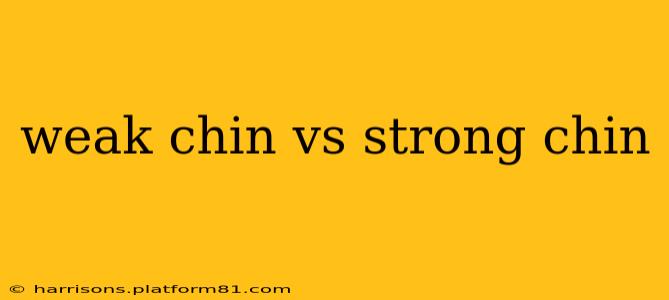Facial structure is a significant aspect of a person's overall appearance, and the chin plays a crucial role in defining the overall shape of the face. The difference between a weak chin and a strong chin is often a matter of personal preference and perception, but there are distinct anatomical features that contribute to this distinction. This article explores the key differences between weak and strong chins, addressing common questions and providing insights into their perceived aesthetic impact.
What is considered a weak chin?
A weak chin, also sometimes referred to as a receding chin or microgenia, is typically characterized by a lack of projection. The chin appears underdeveloped or set back in comparison to the rest of the facial features, particularly the forehead and nose. This can create an imbalance in the facial profile, resulting in a less defined jawline and a softer overall appearance. The degree of "weakness" is subjective and varies greatly among individuals.
What is considered a strong chin?
A strong chin, conversely, is characterized by a prominent and well-defined projection. It's usually square or slightly rounded, extending outward from the face. This projection creates a balanced and harmonious facial profile, often associated with masculinity and strength (though strong chins are found in both men and women). A strong chin often complements a well-defined jawline, enhancing the overall structure of the face.
How can I tell if I have a weak or strong chin?
Assessing your chin's strength involves a visual self-assessment and potentially a consultation with a professional. Look at your profile in a mirror. Does your chin recede significantly compared to your upper lip or nose? Does your jawline appear soft or undefined? If so, you may have a weaker chin. Conversely, if your chin projects prominently and your jawline is well-defined, you likely have a stronger chin. For a definitive assessment, consulting a plastic surgeon or maxillofacial surgeon is recommended.
Can a weak chin be improved?
Yes, there are several options available to improve the appearance of a weak chin. These include:
- Chin augmentation: This surgical procedure involves the insertion of an implant to add projection and definition to the chin.
- Genioplasty: This is a surgical procedure that involves reshaping the chin bone itself.
- Dermal fillers: These non-surgical injections can temporarily add volume to the chin, providing a more defined appearance.
The best option will depend on individual factors and should be determined in consultation with a qualified medical professional.
Are there any health implications associated with a weak chin?
While a weak chin is primarily an aesthetic concern, in some cases, it can be associated with underlying medical conditions affecting jaw development. Severe cases of microgenia might be linked to sleep apnea or temporomandibular joint (TMJ) disorders. However, these connections are not universal, and most individuals with weak chins experience no such health issues. It's always best to consult a medical professional if you have any concerns about your chin's development or associated health problems.
What are the aesthetic preferences surrounding chin shape?
Aesthetic preferences are subjective and vary across cultures and time periods. Historically, different chin shapes have been associated with different ideals of beauty. Currently, many find a strong, well-defined chin to be attractive, as it contributes to a balanced and harmonious facial structure. However, this is not a universal view, and a weak chin isn't inherently unattractive. Ultimately, facial attractiveness is a complex interplay of various features, and the chin is just one piece of the puzzle.
How does chin shape impact facial symmetry?
Facial symmetry plays a large role in overall facial attractiveness. A strong, well-projected chin contributes to better facial balance and symmetry, creating a more harmonious and aesthetically pleasing appearance. A weak chin, on the other hand, can disrupt this symmetry, leading to a less balanced overall facial structure. However, it's crucial to remember that perfect symmetry is rare, and slight asymmetries are often considered normal and even attractive.
This comprehensive guide offers a nuanced understanding of the differences between weak and strong chins, encompassing both aesthetic and potential health considerations. Always consult with a medical professional for personalized advice and treatment options.
